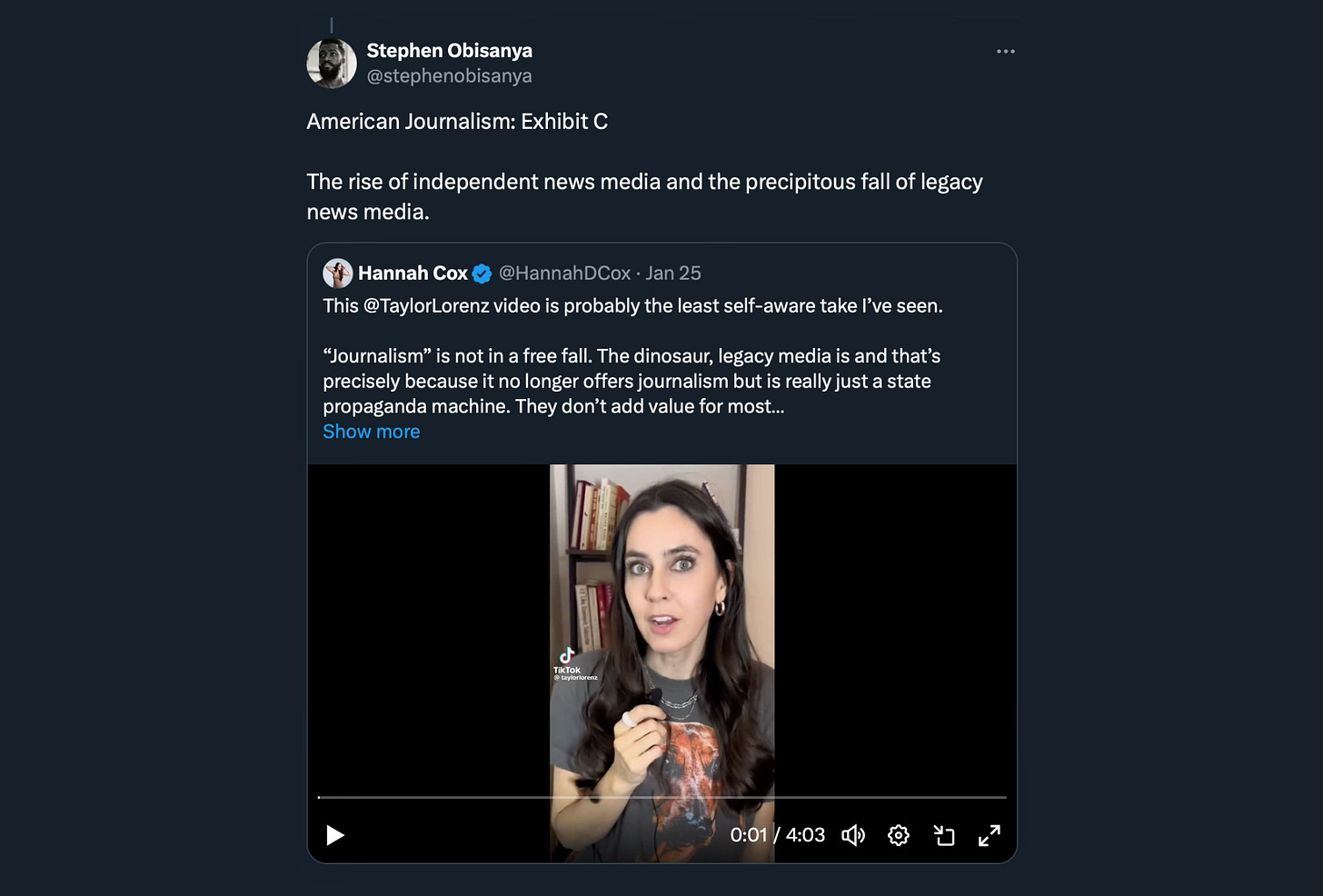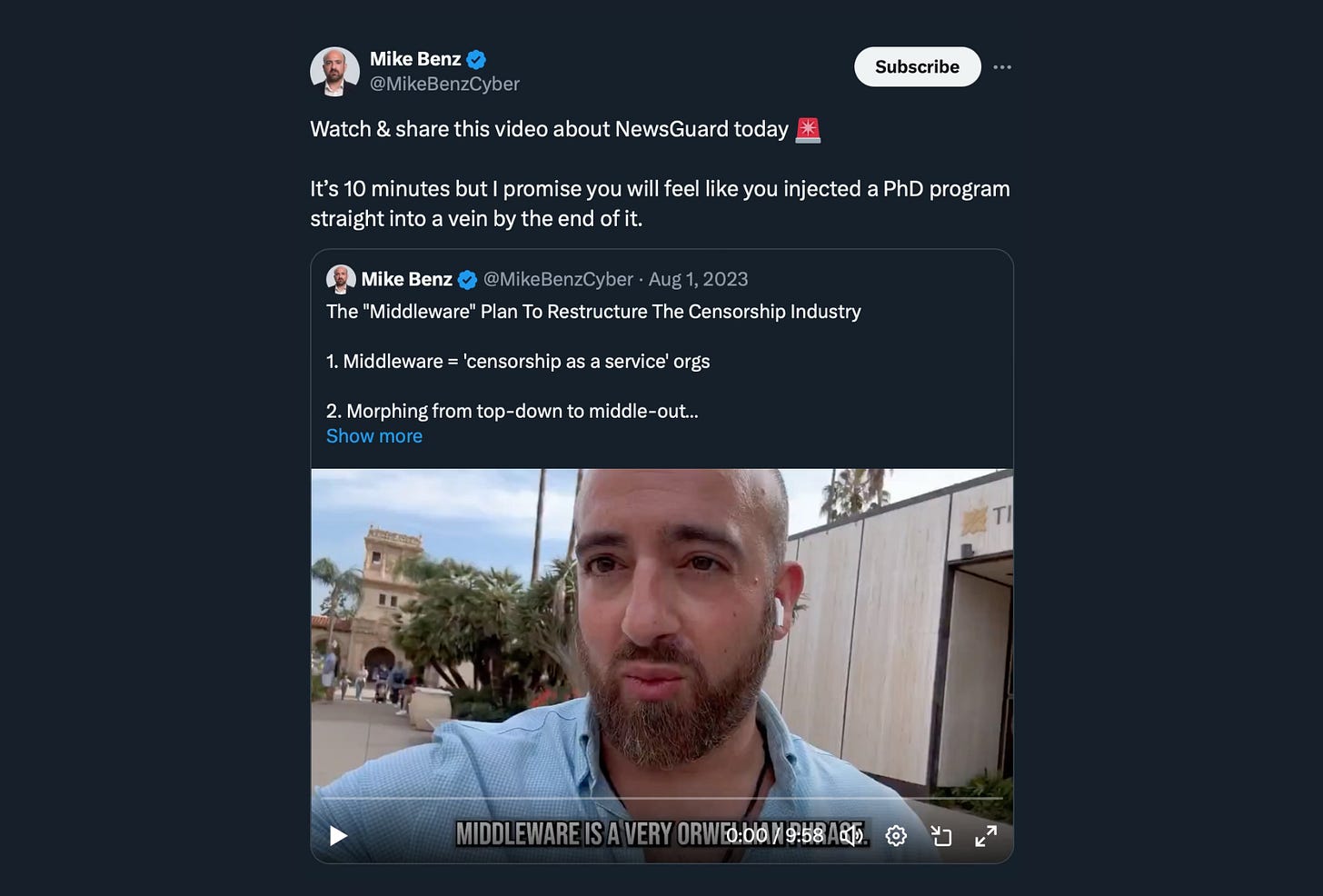If You Can't Censor Them, Infiltrate Them
How legacy news media institutions are reinventing themselves via censorship, and infiltration, of trusted alternative, independent news media platforms.
When legacy news media institutions, from cable networks to publications, lose their identity and responsibility, eventually, they are bound to lose the trust and attention of their readership and viewership. And when readers and viewers abandon these institutional behemoths, it’s usually for greener pastures, in the form of alternative news media platforms whose sole mission is to deliver hard-hitting, investigative journalism unlikely to be covered elsewhere, and tethered to no establishment entity.
This has been the circumstance that American news media organizations have found themselves in for the past few decades, more significantly since 2016. Prior to 2016, news networks and publications struggled to keep ratings up and readership high. The marked shift over the years from breaking noteworthy news events to the around-the-clock, 24/7 cycle of news seemed to have run its course. Something was clearly missing. A return to the drawing board was necessary. But that moment of reflection would not come because a new presidential candidate was about to reinvigorate the entire news industry for the years to come. In 2016, Donald Trump’s presidential campaign, and eventually, his presidency, brought a newfound purpose to a news media landscape that was in dire straits. Instead of a return to the ethics, fundamentals, and core principles of journalism, news networks like CNN chose to capitalize on Trump’s presence in the presidential race by leaning into a more sensationalized and dramatized outlook of the world, stoking conflicts between pundits, chasing virality, and looking to replicate the model that ESPN’s leading daytime talk shows like “First Take” had long established. Trump’s presidential campaign and the events of his presidency fed this model, around the clock. News became less about keeping everyday Americans comprehensively informed about what is happening in the US and the world at large. Instead, news became the source of primetime entertainment, with a cast of characters who needed to play their particular roles for the performative piece to work. On this pivot in strategy, then CNN Worldwide president Jeff Zucker said, “I’ve always been interested in the news, but I’ve always been interested in what’s popular… the idea that politics is sport is undeniable, and we understood that and approached it that way.” Safe to say, it worked out for the network financially, with 2016 being the network’s most profitable year, at the time.
News networks and publications managed to climb out of the financial hole, but in the process, sacrificed whatever was left of their integrity and credibility. The thing is: a strategy that is dependent on capitalizing on sensationalism and the entertainment factor is no strategy for a news organization. It requires more and more outrageous takes, more animus, more ratcheting of mundane events into “breaking news” and worst of all, more separation from the Truth. On Twitter/𝕏, I actually highlight this phenomenon in an ongoing thread “American Journalism: Exhibit X,” which focuses on the propagandistic nature of corporate news media and how far removed from the truth they routinely are. (This little series will continue on my Notes right here on Substack.)

On the subject of abdication of journalistic responsibilities, there’s no one more qualified to speak on the issue than American author and journalist Matt Taibbi, who’s worked inside and outside of news organizations from Russia all the way back to the US, where he worked as a leading contributing editor for Rolling Stone before eventually launching his own publication, right here on Substack (Racket News). In his interviews and talks, he’s made a case, based on firsthand experience, for why 2016 stands alone as the year that journalism took a noticeable nosedive. Why? Because, as he playfully puts it, “the election of Trump broke the minds of journalists and news media outlets.” He argues that corporate journalists in the wake of Trump justified the abdication of their journalistic duties by expressing that they did not want to be wrongfully perceived by their inner circles as “Trump-adjacent,” “conservative",” or “Right-wing extremists.” To avoid this then, they often skewed their reporting and went out of their way to be critical of Trump, even in the select cases where Trump had often made the right policy calls.
As viewers and readers become numbed to these antics, naturally, they go looking elsewhere for an honest representation of world matters, especially at a time when information is ubiquitous, from podcasts and long-form videos to bite-size tweets and long-form articles.
Over the past decade, this audience migration, from legacy news media institutions toward independent news media slowly grew as readers got fed up with the partisanship of news. Readers flocked and subscribed to online independent news publications that promised an alternative and critical look at world matters like The Grayzone, The Intercept, Unlimited Hangout, and more. They followed accounts of leading indie commentators and investigative journalists like Whitney Webb, Glenn Greenwald, Aaron Mate, Max Blumenthal, Abbey Martin, and Matt Taibbi on Twitter/𝕏. Listeners and viewers subscribed to independent Youtube/Patreon channels like System Update, the Jimmy Dore Show, the Kim Iversen Show, O’Keefe Media Group, Due Dissidence, Useful Idiots, Breaking Points, Stay Free with Russell Brand, and so many more. This new influx of readers and viewers with a hunger for alternative, independent news also led to the explosion of revolutionary platforms such as Substack, Rumble, and Locals, among others.
With a burgeoning new media landscape slowly forming and shifting the culture of news consumption away from the mainstream, legacy news media institutions had one of two choices: radically revise their strategies and return to the ethical journalistic standards that once upon a time shaped their reputation as the trusted news sources, or ruthlessly crush and censor the rising voices and platforms in the alternative, independent media space. They chose the latter. Their reasoning: If you can censor all opposition to your propagandistic narratives, you can easily control the narrative, and in essence, dictate what is “true” and what is “false.” This is why talks of “misinformation,” “disinformation,” and “malinformation” have skyrocketed in recent years—government censorship agencies and third-party censorship entities have been erected by institutional powers to systematically determine what falls into each of those categories.
In an effort to expose these massive censorship overreaches, Mike Benz, Executive Director of organization Foundation for Freedom Online, has been painstakingly peeling back the methods employed by these institutions to “cripple the capacities of the alternative news ecosystem,” in short videos like this one, in interviews, essays, and Twitter/𝕏 threads that are the most accurate representation of the “rabbit hole.”
To Benz, a former State Department cybersecurity official, the strategy involves creating an entire censorship industry to effectively kill off the alternative news industry by way of algorithmically limiting reach of platforms that fit the criteria or shutting down the available means of monetization by targeting the platform’s ad revenue source. Indeed, that is how “fact-check” organizations like Snopes, “watchdog” organizations like Media Matters, and news ratings organizations like NewsGuard have come to exist—they are part and parcel of the censorship industry created and funded to discredit accurate news coverage from independent voices/platforms that challenge the narrative hegemony established by legacy news media institutions.

“They created a censorship industry to kill the alternative news industry.”
Even with all the restrictions, alternative news platforms continue to thrive. A majority of the individuals and platforms mentioned earlier have faced direct and sweeping censorship in one way or another due to the type of news stories they regularly break and whom it incriminates. Many have fortunately developed work-arounds to reach their audiences and monetize their content. While others have migrated their audience entirely to new platforms that prioritize freedom of speech over censorship.
Amidst all of this is what I believe may be on the horizon in the months and years ahead; an even more pernicious strategy which may have been set in motion dating back to 2016, but is now slowly presenting as a recognizable pattern — the infiltration of alternative news media by legacy news media affiliates, establishment partners, executive personnel, and former mainstream anchors.
Surely, this is a pattern that, so far, has been documented in seemingly isolated events. But when examined as an aggregate, we have to be willing to pay attention to the strategy at play. Too often have we seen anchors get fired from legacy news media, go through a “rebrand” phase, and reappear as a repented “independent” journalist with a mission to take down the narratives of the networks they were deeply embedded within for decades, until recently. Too often have we seen independent outlets hire executive personnel with experience in legacy news media, only to watch the executives turn the outlet inside out. And too often have we seen alternative platforms embrace compromising funding partnerships that fundamentally transform their core mission and to whom they owe their allegiance.
It’s all happening; from the story of the once independent and “progressive” outlet The Young Turks, to the complete takeover of the groundbreaking and adversarial independent platform The Intercept by senior editors, to ex-CNN anchor and propagandist Chris Cuomo being hired by independent media outlet Valuetainment, to the ouster of independent investigative journalist James O’Keefe from his own news organization Project Veritas following one of his most consequential stories, to yet another disgraced and entitled ex-CNN anchor and propagandist Don Lemon almost being onboarded as 𝕏’s the first news personality, before being unceremoniously dumped for his utter lack of journalistic integrity, and countless other similar accounts. These are cautionary tales of how entire investigative operations can be inconspicuously gutted and replaced by new driving objectives that favor the major news institutions and their preferred narratives.
I believe these are patterns to be on the lookout for as alternative news media platforms continue to grow and present a formidable opposition to legacy news media institutions. Many of the alternative personalities and platforms I once trusted as critical sources to expose corruption and hold those in power to account (i.e. The Daily Show’s Jon Stewart, NPR, etc.) have long forsaken that muckraking mission for a more agreeable take on the news that do not ruffle the feathers of institutional powers.
It’s worth remembering that if the censorship strategy is not successful, infiltration is the way that legacy news media institutions reinvent themselves for a new generation of dissidents. Or perhaps, a combination of both.




It would seem to me that it was not only the 2016 election that poured gasoline on the dumpster fire that is legacy media, but also the teaching in schools of ESG promotion in news. Many, many young journalists believe objectivity is not only not desirable, it's not possible. The new journalistic standards promote the correct take on events to advance society in the proper direction. Vetting a story, the facts, the conflicts of interests, the power players, who benefits, etc. is not necessary because the goal is to move in a 'moral' direction. Everything is in service of this.